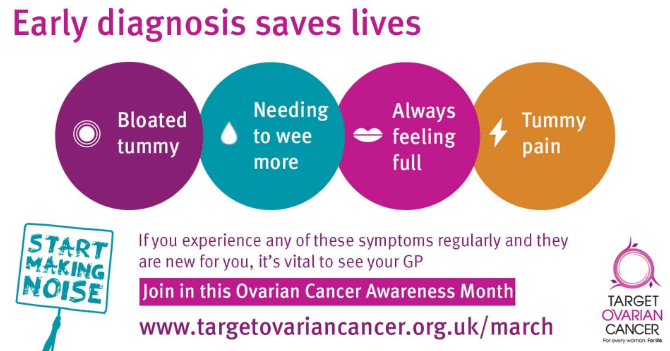One of my personal missions in life is to raise awareness of the signs and symptoms of Ovarian Cancer as they can so easily be missed early on and this can have devastating effects, as it did on my family. The earlier the disease is detected, the easier it is to treat.
The following is an excerpt from my book “From Cancer To Coddiwomple – A Story of Love, Loss and Daring to Dream” and I’m sharing it here to encourage ladies to be vigilant:
“I confess I was ignorant about Ovarian Cancer. I hadn’t heard much about it before and I was soon to discover how common it is. I was shocked at how many people said: “oh my Nan has had that, she was fine”, or “my mum had that, they can treat it easily nowadays.
Why hadn’t I heard of it?
I set about researching the disease and I found various websites and charities solely devoted to this cancer and I was frightened by the words “it is also known as The Silent Killer”.
As far as I know Mum didn’t present with any other symptoms other than the bloated abdomen. If she had been experiencing any other problems, she never said anything. Mum might have got an earlier diagnosis if only she had noticed any of these other symptoms beforehand.I learnt that symptoms include:
● Persistent bloating – not bloating that comes and goes
● Feeling full quickly and/or loss of appetite
● Pelvic or abdominal pain (that’s your tummy and below)
● Urinary symptoms (needing to wee more urgently or more often than usual)
Occasionally there can be other symptoms:
● Changes in bowel habit (e.g diarrhoea or constipation)
● Extreme fatigue (feeling very tired)
● Unexplained weight loss
Any bleeding after the menopause should always be investigated by a GP.
Symptoms will be:
● Frequent – they usually happen more than 12 times a month
● Persistent – they don’t go away
● New – they are not normal for you
(the above is reproduced with kind permission from the charity Target Ovarian Cancer.)
Ovarian Cancer consists of four stages and some of these can be subdivided depending on where the cancer has spread. At stage 1 the cancer causes few ymptoms and most women are not aware that anything is wrong. The outlook is usually good if it is caught this early and surgery may be all that’s needed to treat it.
Stage 2 is when it has spread outside the ovary into the pelvis or has gone into the womb. There are two other subdivisions to this stage (b & c) and treatment can consist of surgery and chemotherapy. Only a small number of women are diagnosed at this stage.
Stage 3 is the most common stage of diagnosis. At this stage the cancer may have spread to the lining of the abdomen, the surface of the bowel, the omentum (a layer of fatty tissue that insulates the abdominal organs) and the lymph nodes in the pelvis or around the aorta. A surgeon will try to remove as much of the tumour as possible and probably follow it up with a course of chemotherapy and possibly more surgery.
Mum’s cancer had already reached stage 4 when she got her diagnosis. This meant the cancer had spread beyond the abdomen to the liver or lungs. Sometimes the cancer spreading to the lungs may be the first symptom of the cancer, symptoms include shortness of breath or a cough. Stage 4a is when the cancer has spread to the lungs.
Stage 4b is when the cancer has spread to the liver. Stage 4 can be treated with surgery and chemotherapy, or just chemotherapy.” © Wendy Jennings
Useful information: Target Ovarian Cancer – the country’s leading Ovarian Cancer charity
“From Cancer To Coddiwomple – A Story of Love, Loss and Daring to Dream” is available as a paperback via thecoddiwomplelady.com

